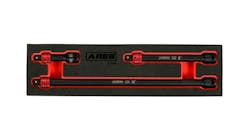It’s not unusual to encounter a System Lean Diagnostic Trouble Code (DTC) on a vehicle if you routinely work on Check Engine light problems. Vacuum leaks and fuel delivery problems are common causes for these common codes, and you might be tempted to focus immediately on these. But there are many other causes that can illuminate the MIL for the P0171 and P0174 DTCs that you also need to consider.
Additional causes that can lead to these particular codes include Mass Airflow (MAF) sensor signal problems, voltage drop anywhere in the fuel delivery circuit, problems in the oxygen sensor inputs to the Engine Control Module (ECM), Exhaust Gas Recirculation (EGR) problems, exhaust leaks, Positive Crankcase Ventilation (PCV) valve calibration, dipstick sealing (mostly European vehicles), engine mechanical problems and faulty ECMs. With so many possible causes to consider, you would think that it would take some time to find the cause of the P0171 – P0174 DTCs.
Where do you go next? Well it’s always a good idea to look for applicable OEM Technical Service Bulletins (TSBs) using your preferred service information source. Next place I like to go are the aftermarket information sources like Identifix and iATN. Even a generic Google search can help you locate common problems that might be related to the one you are facing in your bay. A few words of caution, though, are in order. First, be careful of the source of any information you find online. Not all Internet experts are what they claim to be. Second, don’t treat any information you find as a “silver bullet” that you blindly apply to your repair. Test, don’t guess, and if your testing confirms that the Internet fix will do the job, fine. Otherwise, continue your diagnosis.
Our case study vehicle was at two other repair shops that replaced components just because a TSB stated that the ECM, MAF and VSV (Vacuum Switching Valve) could cause the problem. The replacement of the components did not repair the vehicle or fix the P0171 DTC. Take a look at this 16-page TSB (EG051-05: 05-06) that the vehicle owner was given for the P0171 problem. The shops looked at and followed the Toyota procedure on the diagnostic trouble chart. Because I did not get the vehicle with the old components to test, I cannot say if the components that were replaced were either bad or good. The only thing that I can tell you is that this vehicle came into our shop with the MIL back on and the same code complaint the customer started with.
The MAF sensor can be tested using your Generic/Global scan data Calculated Load PID. Set up your scan tool to graph and record, and then take the car out for a test drive. Perform a few low speed, Wide Open Throttle (WOT) accelerations from a rolling start (being sure you do so safely and legally). Calculated Load should be in the range of 90 percent just before the shift to second gear. Another important test to perform that can cause problems along with failing MAF sensor results is back-pressure testing. Make sure that the engine does not have more than 0.5 pound/226.80g at idle and no more than 1.5 pounds/680.39g at 2,500 rpm. Because fuel delivery is another important component in keeping the MIL off on a P0171, you can add propane to see if fuel trim moves while the AFR sensor voltage goes low (rich). If you confirmed that the AFR sensor is responding to the propane being added and the STFT is moving as well you just confirmed that the PCM is responding properly to the fuel being added.
Using my game plan, I started with the Freeze Frame data. The data recorded that Long Term Fuel Trim (LTFT) was at its upper failure limit and the engine was cold at the time of the failure. These are two important facts that help us consider our next step in tracking down the problem. The car had just arrived at the shop when I began taking a look and still warm. Any attempt to test for the fault then would have been a waste of time, so I let the engine cool down before beginning the next step in my diagnostic plan.
We located the problem when the gas analyzer displayed the highest CO2 reading by the intake manifold. To confirm the problem, we shut off the CO2 and the readings dropped. The next step was to start the cold engine up while monitoring the Short Term Fuel Trim (STFT) and LTFT readings. The Fuel Trim chart on the EScan plotted the trim numbers for me, and showed that the readings were really high (positive corrections) at idle as well as when I power braked the vehicle at higher rpm. This was the proof needed to convict the intake manifold of causing the problem — case closed.
After confirming the repair, it’s a wonder that the other two shops could not find the problem as easily as we did. The key, I think, was reviewing the Freeze Frame data and testing under the same conditions that the ECM did. I suspect the previous attempts at locating the problem where done on a hot engine but by that time parts had expanded enough to seal the leak that ultimately resulted in the P0171 the customer was trying to have repaired. Many thanks, though, to the other shops. I can always use a new customer.




